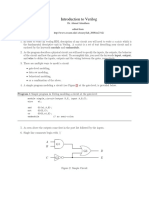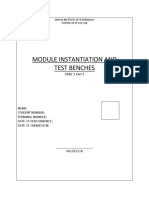T3 Verilog4CombinationalLogic
T3 Verilog4CombinationalLogic
Uploaded by
0307aliCopyright:
Available Formats
T3 Verilog4CombinationalLogic
T3 Verilog4CombinationalLogic
Uploaded by
0307aliOriginal Description:
Original Title
Copyright
Available Formats
Share this document
Did you find this document useful?
Is this content inappropriate?
Copyright:
Available Formats
T3 Verilog4CombinationalLogic
T3 Verilog4CombinationalLogic
Uploaded by
0307aliCopyright:
Available Formats
EE421 DIGITAL
SYSTEMS DESIGN
REFERENCE:
Verilog Programming for Implementing Combination Logic
CE303 DIGITAL SYSTEMS II
02 October 2009
Abdullah Mansoor
Dept of Electrical Engineering
NUST School of Electrical Engineering and Computer Sciences
(SEECS)
Gate Level Modeling
Used to describe Combinational Logic
circuits using Verilog
Coding is comparatively simpler as
compare to higher level of modeling
Use blocking statements
Design Example: XOR gate
XOR
out1=a.b + b.a
Design Example: XOR gate
module <NAME> (<LIST OF PORTS>);
//port Declarations
//data type/variables declaration
//functionality in terms of structural or behavioral style
end module
Design Example: XOR gate
module myXOR (a, b, out1);
//port Declarations
//data type/variables declaration
//functionality in terms of structural or behavioral style
end module
Note:
Good programming style is to use self explanatory port names
Do not use pre-defined keywords
Design Example: XOR gate
Step1: Port Declarations
module myXOR (a, b, out1);
input a, b;
output out1;
//data type/variables declaration
//functionality in terms of structural or behavioral style
end module
PORT Declarations:
input : Input port
output: Output port
inout: Bidirectional port
Note: inout usually used for power supply ports or other bidirectional ports
Design Example: XOR gate
Step2: Data Type Declaration
module myXOR (a, b, out1);
input a, b;
output out1;
wire a_br, b_br, and1out, and2out, out1;
//functionality in terms of structural or behavioral style
end module
Verilog Data Types:
There are three important data types in addition to other data types
available in C:
Nets: To describe interconnection between devices
Nets are further classified as wire, wand, wor etc.
Registers: To represent storage elements
Parameters: user-defined constants
Note: To know more about data types consult sec 3.2 PAL
Design Example: XOR gate
Step3: Structural Implementation
module myXOR (a, b, out1);
input a, b;
output out1;
wire a_br, b_br, and1out, and2out, out1;
not nota (a_br, a);
not notb (b_br, a);
and and1(and1out, a, b_br);
and and2(and2out, b, a_br);
or or1(out1, and1out, and2out);
end module
Not: Syntax for Instantiation:
<Buit-in gates or predefined Modules> <instance_name>(interconnections;output is first then
inputs);
Design Example: XOR gate
Step3: Behavioral Implementation
module myXOR (a, b, out1);
input a, b;
output out1;
assign out1=(a & ~b) | (~a & b);
end module
Continuous assignment:
The RHS is assigned to LHS immediately
(except for small delay associated in calculation)
Continuous Assignment
Represents true Hardware implementation
Cannot implement some functionalities
Edge triggering
Sequential style code like case statements
etc.
These functions are added using non-
continuous assignments
Non-continuous assignments
These can be implemented either using
always or initial block in Verilog code
Example always block
module myXOR (a, b, out1);
input a, b;
output out1;
reg out1;
always @ (a or b) begin
out1=(a & ~b) | (~a & b);
end
end module
Register type out1. Not really a
register. Just Verilog Syntax.
Sensitivity list triggers action in the body
Design Example2: 2-to-1 MUX
/* 2-to-1 mux implementation*/
module myMUX (a, b, select, out1);
input a, b, select;
output out1;
wire select_br, and1out, and2out;
not (select_br, select);
and (and1out, select_br, a);
(and2out, select, b);
or (out1, and1out, and2out);
end module
Design Example3: 4-to-1 MUX
Design Example3: 4-to-1 MUX
/* 2-to-1 mux implementation*/
module myMUX4 (a, b, c, d select, out1);
input a, b, c, d;
Input [1:0] select;
output out1;
wire m1, m2;
myMUX
m0 (.select(select[0]), .a(a), .b(b), .out(m1));
m1 (.select(select[0]), .a(c), .b(d), .out(m2));
m2 (.select(select[1]), .a(m1), .b(m2), .out(out1));
end module
Design Example3: 4-to-1 MUX
Using Non-Continuous assignment
/* 2-to-1 mux implementation*/
module myMUX4 (a, b, c, d select, out1);
input a, b, c, d;
input [1:0] select;
output out1;
reg out1;
always @ (a, b, c, d, select)
case (select)
2b00: out1=a;
2b01: out1=b;
2b10: out1=c;
2b11: out1=d;
end
end module
Simulation and Testing using Verilog
Test Bench
module testbench;
//data type declaration
//instantiate modules
//Apply Stimulus
//Display Results
end module
Test Bench MUX
module testbench;
//define variables
reg a, b;
wire out1;
//instantiate modules
myXOR XOR1 (a, b, out1);
initial begin //Apply Stimulus
a=1b0;
b=1b0;
#5 a=1b1;
#5 a=1b1;
----------
----------
#100 $stop
end
initial begin //Display Results
$display(a=%b, b=%b, out1=%b, a, b , out1);
end
end module
Reading Assignment:
Sec 3.2, Sec 6.3, and 6.4
Thank you!
You might also like
- IDP - SAP SuccessFactors Work Zone - Migration and Implementation Considerations - v2.2.1Document25 pagesIDP - SAP SuccessFactors Work Zone - Migration and Implementation Considerations - v2.2.1shikha010591No ratings yet
- Exercise Questions Solutions. Chapter-2: AnswerDocument36 pagesExercise Questions Solutions. Chapter-2: Answersureshfm1100% (15)
- Educ Chapter 6 Lesson - CompressDocument19 pagesEduc Chapter 6 Lesson - CompressMhay Pale BongtayonNo ratings yet
- Disha Sbi Bank Po MTDocument414 pagesDisha Sbi Bank Po MTRajeswari Koppisetti100% (1)
- HDL Model of Combinational CircuitsDocument6 pagesHDL Model of Combinational CircuitsMunwar Ali Sd100% (2)
- VERILOG HDL - Tutorial, PPT FormatDocument30 pagesVERILOG HDL - Tutorial, PPT FormatArslan Kiani100% (2)
- Social Media ProposalDocument2 pagesSocial Media Proposal0307ali100% (1)
- Social Media ProposalDocument2 pagesSocial Media Proposal0307ali100% (1)
- 50 Popular English Idioms To Sound Like A Native SpeakerDocument16 pages50 Popular English Idioms To Sound Like A Native SpeakerRUDRAPRADEEPTAK100% (2)
- Verilog GATE AND DATA FLOWDocument64 pagesVerilog GATE AND DATA FLOWPRIYA MISHRANo ratings yet
- Verilog Tutorial: Chin-Lung SuDocument42 pagesVerilog Tutorial: Chin-Lung Suajay_kr931No ratings yet
- (System) Verilog Tutorial: Aleksandar MilenkovićDocument56 pages(System) Verilog Tutorial: Aleksandar MilenkovićAbhinav TallapallyNo ratings yet
- Module Instantiation and Test Benches: Drill 1Document16 pagesModule Instantiation and Test Benches: Drill 1Anonymous GmAK78eFjfNo ratings yet
- HDLDocument141 pagesHDLsauryan123No ratings yet
- Verilog Lec s03Document126 pagesVerilog Lec s03Bruno SilvaNo ratings yet
- Intro HDLDocument141 pagesIntro HDLAnonymous IN80L4rRNo ratings yet
- ENEL111 Digital Electronics: Richard Nelson G.1.29Document38 pagesENEL111 Digital Electronics: Richard Nelson G.1.29prashantvlsiNo ratings yet
- Module Instantiation and Test Benches: Drill 1Document9 pagesModule Instantiation and Test Benches: Drill 1Roland ManaloNo ratings yet
- Modeling Styles and Testbenching in Verilog HDL: Dr. Belgacem Ben YoussefDocument46 pagesModeling Styles and Testbenching in Verilog HDL: Dr. Belgacem Ben YoussefBen YoussefNo ratings yet
- Digital Circuit Verification Hardware Descriptive Language VerilogDocument17 pagesDigital Circuit Verification Hardware Descriptive Language VerilogFreyja SigurgisladottirNo ratings yet
- Introduction To Verilog: Dr. Ahmad AlmulhemDocument4 pagesIntroduction To Verilog: Dr. Ahmad AlmulhemsalNo ratings yet
- Birla Institute of Technology & Science, Pilani Lab Sheet - 1Document7 pagesBirla Institute of Technology & Science, Pilani Lab Sheet - 1SATYAVRAT SHARMANo ratings yet
- VerilogDocument42 pagesVerilogvalidsecondNo ratings yet
- Lab 02 Gate Level ModelingDocument10 pagesLab 02 Gate Level Modelingrizwan900No ratings yet
- Ch-2 Hardware Descriptive Lanquage_2Document50 pagesCh-2 Hardware Descriptive Lanquage_2Sangeeth WeragodaNo ratings yet
- Intro To HDL MidtermDocument112 pagesIntro To HDL MidtermchienikolaoNo ratings yet
- Experiment No. 1: Switch and Gate Level Modeling Pre Lab TaskDocument17 pagesExperiment No. 1: Switch and Gate Level Modeling Pre Lab TaskMuhammad ShoaibNo ratings yet
- Verilog.pptx1Document75 pagesVerilog.pptx1agnieracingNo ratings yet
- Drill 1 Part 1 Rev1Document10 pagesDrill 1 Part 1 Rev1kage mushaNo ratings yet
- Verilog Tutorial1Document37 pagesVerilog Tutorial1maheshsharmapNo ratings yet
- Drill 1Document10 pagesDrill 1kage mushaNo ratings yet
- Verilog HDL Introduction: ECE 554 Digital Engineering LaboratoryDocument79 pagesVerilog HDL Introduction: ECE 554 Digital Engineering LaboratoryBbsn EmbeddedNo ratings yet
- Intro To VerilogDocument68 pagesIntro To VerilogNicolas AmezquitaNo ratings yet
- Fallsem2019-20 Ece2003 Eth Vl2019201000898 Reference Material I 10-Sep-2019 Cat 2 Digital Note Book Without AnswerDocument34 pagesFallsem2019-20 Ece2003 Eth Vl2019201000898 Reference Material I 10-Sep-2019 Cat 2 Digital Note Book Without AnswermrjNo ratings yet
- 102 2 DigitalCircuitLab Vlog3Document17 pages102 2 DigitalCircuitLab Vlog3Mit Vasant MorbiaNo ratings yet
- Module Instantiation and Test Benches: - ProfessorDocument7 pagesModule Instantiation and Test Benches: - ProfessorKayecilyn MalabananNo ratings yet
- Verilog HDLDocument62 pagesVerilog HDLc406400100% (1)
- Logic Design LaboratoryDocument9 pagesLogic Design LaboratoryKerim NjuhovićNo ratings yet
- 15CS202 UnitvDocument142 pages15CS202 UnitvChristina josephine malathiNo ratings yet
- Ver I Log ExamplesDocument22 pagesVer I Log ExamplesDayanand Gowda KrNo ratings yet
- Unit 1 - LP5Document14 pagesUnit 1 - LP5gokul.sengottaian1No ratings yet
- Verilog HDL ModelingDocument38 pagesVerilog HDL ModelingtejavardhanedeNo ratings yet
- Verilog Lecture 3 - NoopurDocument64 pagesVerilog Lecture 3 - NoopurMonis KhanNo ratings yet
- Chapter 5 VHDL UITM Sem 6 Electrical EngineeringDocument46 pagesChapter 5 VHDL UITM Sem 6 Electrical EngineeringDyrul SyaznanNo ratings yet
- Verilog HDL PDFDocument20 pagesVerilog HDL PDFMinh NamNo ratings yet
- Hardware Description Language (HDL) What Is The Need For Hardware Description Language? Model, Represent, and Simulate Digital HardwareDocument26 pagesHardware Description Language (HDL) What Is The Need For Hardware Description Language? Model, Represent, and Simulate Digital HardwareGohar AyubNo ratings yet
- Lab 07Document10 pagesLab 07api-241454978No ratings yet
- Verilog Session 1,2,3Document68 pagesVerilog Session 1,2,3Santhos KumarNo ratings yet
- Verilog ReferenceDocument77 pagesVerilog ReferencePRANJAL SHRIVASTAVANo ratings yet
- Chapter 4:: Hardware Description Languages: Digital Design and Computer ArchitectureDocument33 pagesChapter 4:: Hardware Description Languages: Digital Design and Computer ArchitectureSattar Chandra SekharNo ratings yet
- Lecture-5Modelling TechniquesDocument46 pagesLecture-5Modelling TechniquessanujNo ratings yet
- Week 1-2 Introduction To Hardware Description LanguageDocument23 pagesWeek 1-2 Introduction To Hardware Description LanguageReuel Patrick CornagoNo ratings yet
- MR18 DE Lab Manual_merged (5)Document88 pagesMR18 DE Lab Manual_merged (5)asdfasdf01124No ratings yet
- Introduction To Digital Design Using VHDL: WWW - Xtrabits.inDocument46 pagesIntroduction To Digital Design Using VHDL: WWW - Xtrabits.inshravangantlaNo ratings yet
- Chapter 7 Parameters Task and Function in VerilogDocument34 pagesChapter 7 Parameters Task and Function in Veriloghieu27718No ratings yet
- Lab 4 Verilog Gate Level ModellingDocument11 pagesLab 4 Verilog Gate Level Modellingsafdarmunir070No ratings yet
- FPGA Based System Design PPT End Sem - Student - UpdatedDocument625 pagesFPGA Based System Design PPT End Sem - Student - UpdatedVaishnavi PanduranganNo ratings yet
- Verilog LabDocument96 pagesVerilog LabRaghunandan KomandurNo ratings yet
- Lab # 2 Verilog Structure: 2.1 ModulesDocument5 pagesLab # 2 Verilog Structure: 2.1 ModulesThe Common YoutuberNo ratings yet
- Logic Design Lab Verilog 101Document49 pagesLogic Design Lab Verilog 101杜岳100% (1)
- VHDLDocument27 pagesVHDLsaranshdaveNo ratings yet
- Verilog Lecture NotesDocument92 pagesVerilog Lecture NotesRavi KishoreNo ratings yet
- verilogDocument87 pagesverilogyasminbrandsNo ratings yet
- Chapter1: Introduction To VerilogDocument15 pagesChapter1: Introduction To Verilogarunguptha_gsNo ratings yet
- Practical Reverse Engineering: x86, x64, ARM, Windows Kernel, Reversing Tools, and ObfuscationFrom EverandPractical Reverse Engineering: x86, x64, ARM, Windows Kernel, Reversing Tools, and ObfuscationNo ratings yet
- Carbon Capture and Storage - A Road To Cleaner FutureDocument7 pagesCarbon Capture and Storage - A Road To Cleaner Future0307aliNo ratings yet
- Dye Sensitized Solar Cells Tool To Over Come The Future Energy Crisis JREAC.1000e106Document2 pagesDye Sensitized Solar Cells Tool To Over Come The Future Energy Crisis JREAC.1000e1060307aliNo ratings yet
- Light SensorsDocument32 pagesLight Sensors0307aliNo ratings yet
- Sustainable Development 5Document14 pagesSustainable Development 50307aliNo ratings yet
- Pilkington Sunplus BIPV Brochure January 2018Document8 pagesPilkington Sunplus BIPV Brochure January 20180307aliNo ratings yet
- Arab Health RegistrationDocument3 pagesArab Health Registration0307aliNo ratings yet
- CO2 Cap Store 2Document24 pagesCO2 Cap Store 20307aliNo ratings yet
- Towards Sustainable Energy: Carbon Capture, Utilization and StorageDocument20 pagesTowards Sustainable Energy: Carbon Capture, Utilization and Storage0307aliNo ratings yet
- ENV130.0001, Renewable Energy Sources, Wang, Chunzeng Fall 2012 PDFDocument4 pagesENV130.0001, Renewable Energy Sources, Wang, Chunzeng Fall 2012 PDF0307aliNo ratings yet
- Stand-Alone PV SystemDocument1 pageStand-Alone PV System0307aliNo ratings yet
- ISE1D02Document11 pagesISE1D020307aliNo ratings yet
- Dated: October 16th 2014: OwnershipDocument2 pagesDated: October 16th 2014: Ownership0307aliNo ratings yet
- ENV130.0001, Renewable Energy Sources, Wang, Chunzeng Fall 2012 PDFDocument4 pagesENV130.0001, Renewable Energy Sources, Wang, Chunzeng Fall 2012 PDF0307aliNo ratings yet
- EE 555 - Renewable Energy Systems - Hassan Abbas KhanDocument3 pagesEE 555 - Renewable Energy Systems - Hassan Abbas Khan0307aliNo ratings yet
- Rfi # Priority Request Description Current StatusDocument6 pagesRfi # Priority Request Description Current Status0307aliNo ratings yet
- First-Order Circuits (7.1-7.2) : Dr. Holbert April 12, 2006Document26 pagesFirst-Order Circuits (7.1-7.2) : Dr. Holbert April 12, 20060307aliNo ratings yet
- Fluid Mechanics 3Document3 pagesFluid Mechanics 30307aliNo ratings yet
- Australasian HFG Standard Components Pbtr-A12 Patient Bay - Acute Treatment, 12mDocument3 pagesAustralasian HFG Standard Components Pbtr-A12 Patient Bay - Acute Treatment, 12m0307aliNo ratings yet
- iHFG Standard Project: Milestone: Version 4Document1 pageiHFG Standard Project: Milestone: Version 40307aliNo ratings yet
- Form 2.16.3Document9 pagesForm 2.16.30307aliNo ratings yet
- Form 2.16.3Document2 pagesForm 2.16.30307aliNo ratings yet
- Stall Holder Entry 2014Document2 pagesStall Holder Entry 20140307aliNo ratings yet
- Môn Thi: Tiếng Anh Ngày thi: 29/6/2012 Thời gian làm bài: 60 phút (không kể thời gian giao đề)Document2 pagesMôn Thi: Tiếng Anh Ngày thi: 29/6/2012 Thời gian làm bài: 60 phút (không kể thời gian giao đề)Marie.NgoNo ratings yet
- iOS Development - Swift Coding Guidlines-MOBILOITTEDocument20 pagesiOS Development - Swift Coding Guidlines-MOBILOITTEIndrajeet MishraNo ratings yet
- Jemar M. Bandaja - Assessment 2Document3 pagesJemar M. Bandaja - Assessment 2jmNo ratings yet
- An Exhaustive Study On Different Sudoku Solving Techniques: KeywordsDocument7 pagesAn Exhaustive Study On Different Sudoku Solving Techniques: KeywordsRavi ShankarNo ratings yet
- Περί Των Εσχατολογικών Ομιλιών Του Αγίου Εφραίμ Του Σύρου· Ανάλυση Της «Ελεύσεως Του Αντιχρίστου»Document23 pagesΠερί Των Εσχατολογικών Ομιλιών Του Αγίου Εφραίμ Του Σύρου· Ανάλυση Της «Ελεύσεως Του Αντιχρίστου»Μοσχάμπαρ ΓεώργιοςNo ratings yet
- Ovirt VDSMDocument52 pagesOvirt VDSMvincentvdkNo ratings yet
- Final Exam A1Document7 pagesFinal Exam A1Ace AbdrakhmanovNo ratings yet
- Velugotivari VamsavaliDocument257 pagesVelugotivari Vamsavalinrk1962No ratings yet
- Full Download Public Law Text cases and material Andrew Le Sueur PDF DOCXDocument65 pagesFull Download Public Law Text cases and material Andrew Le Sueur PDF DOCXfiolaheyob54No ratings yet
- Cooperative Learning Methods: Robert E. SlavinDocument6 pagesCooperative Learning Methods: Robert E. SlavinAjit MondalNo ratings yet
- Shortcut Keys For Libreoffice WriterDocument5 pagesShortcut Keys For Libreoffice WriterJunaid KhanNo ratings yet
- PDIM 104 Lecture03 - VariablesDocument33 pagesPDIM 104 Lecture03 - VariablesPaa Kwesi Kwahin AnnanNo ratings yet
- Lab - 11 - File Handling in PythonDocument6 pagesLab - 11 - File Handling in PythonWaseem AbbasNo ratings yet
- 100 Most Asked JavaScript InterviewDocument12 pages100 Most Asked JavaScript InterviewShanoor BalekundriNo ratings yet
- Parameter RM 300C EnglishDocument1 pageParameter RM 300C EnglishMahmoud Alswisy100% (1)
- ReadingDocument36 pagesReadingLan AnhNo ratings yet
- Anexo C ProgramacionDocument8 pagesAnexo C ProgramacionandresNo ratings yet
- Intermediate Wordlist With English Profile Level DescriptionDocument14 pagesIntermediate Wordlist With English Profile Level DescriptionDiego DimNo ratings yet
- The Structure of Urdu - Case: Miriam ButtDocument19 pagesThe Structure of Urdu - Case: Miriam ButtUmar AliNo ratings yet
- Staad Output FileDocument8 pagesStaad Output FilePriyanshi DixitNo ratings yet
- Silo - Tips - Digital Signatures For Sap Applications Using The Digital Signature Tool Developer Guideline and Best PracticesDocument25 pagesSilo - Tips - Digital Signatures For Sap Applications Using The Digital Signature Tool Developer Guideline and Best PracticesJason CraigNo ratings yet
- Komande Cal2000 PDFDocument1 pageKomande Cal2000 PDFnedp18No ratings yet
- Daily Lesson LogDocument2 pagesDaily Lesson Logjovie.villanueva001No ratings yet
- Timing Diagram 8085 FinalDocument29 pagesTiming Diagram 8085 FinalgokulchandruNo ratings yet
- UML Diagram Online Shopping UML Use CaseDocument11 pagesUML Diagram Online Shopping UML Use CaseThông Nguyễn100% (2)
- JavaDocument115 pagesJavalornahlavineNo ratings yet















































































































